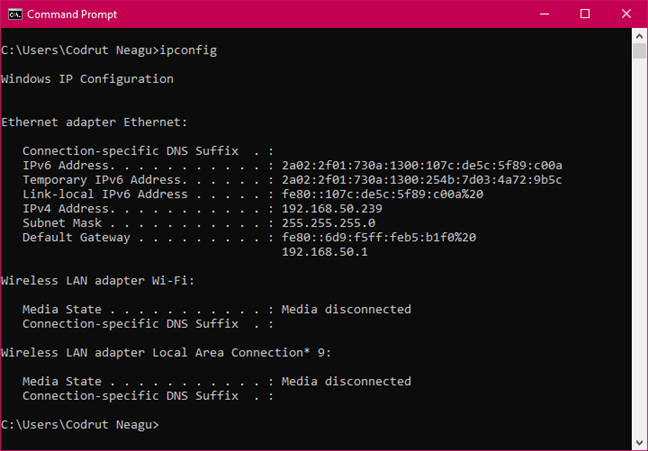

- #Network command prompt commands how to
- #Network command prompt commands install
- #Network command prompt commands series
- #Network command prompt commands windows
#Network command prompt commands series
#Network command prompt commands windows
The Linux version of Ping has more options than the Windows version and the two implementations use different codes for the same options. Options are indicated by a minus sign (“-”), as with the Windows implementation. At that point, the facility produces a summary report for the number of requests that have been successfully completed. The utility will keep sending out echo requests until the user types Control-C. The default status of Ping on Linux is the interactive mode, which a user on a Windows system would need to use the -t option. The results report shows the total packet size, including the header length – on a packet with a 56-byte payload this will be 64 bytes. The main difference between Ping on Linux and Ping on Windows is that the data payload on a Linux Ping request packet is 56 bytes long.
#Network command prompt commands install
However, you probably won’t need to install this because it is pre-loaded in just about all Linux distros. The -c (routing compartment identifier) and -p (ping a Hyper-V server) options do not exist in the Windows Server versions. The list of options with Windows Server is shorter than the Windows version. For example, the command to get a list of options on Windows Server is ping /h instead of ping -h. On Windows Server, the character that precedes each option is a slash (“/”).

There are a couple of differences between the implementation of Ping on Windows and Windows Server. w Timeout in milliseconds to wait for a response.t Continuous request issued until the user specifies to stop with Control-C.i Maximum number of hops to cross when replying (TTL).a Resolve the IP address given to a hostname before sending echo requests.If the device being tested as the destination is on a local network, the target name can be that device’s hostname. The only parameter for the command is the target name, which can be an IP address or a domain name. Switches or options, on the utility, are preceded by a minus sign (“-”). On Windows, the Ping utility sends four requests by default that can be altered through a switch in the command. However, the options on the command can be written in any order and the target address can appear anywhere after the command name. There are slight variations in the format of the command according to the operating system running it. This is because the command first has to go and retrieve the destination IP address for the target. to You can give a domain name instead, so that ping will check on the DNS system that you are using. The command requires a destination IP address in order to launch. The ping command is available in all operating systems and it behaves in much the same way for all versions. This tool sends a series of test packets, which are ICMP echo requests. By default, the tool can also detect if a destination is unreachable – if no response arrives, there is a problem. The utility sends a small packet to a given address and waits for a response from the target computer.

Ping uses these confirmation messages to measure roundtrip time (RTT) on a path to a target. ICMP was specified to provide status feedback on connections and packet transmissions. Ping exploits a feature in the Internet Control Message Protocol.
#Network command prompt commands how to
However, the aim of this guide is to provide information on how to get the best out of these free facilities.Īlthough network monitoring tools offer better automation, using free network commands helps the network administrator get a better understanding of how a network operates. This guide to network troubleshooting commands includes a number of utilities of which you are probably already aware. The commands that launch those enquirers provide very useful information for network troubleshooting. This requirement has the benefit of offering query commands that give live feedback on different utilities that operate the network. Any computer connected to a network needs to be able to process communication protocols.


 0 kommentar(er)
0 kommentar(er)
